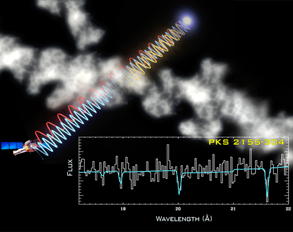July 31, 2002
RELEASE: 02-145
NASA’s Chandra X-ray Observatory has discovered part of an intergalactic web of hot gas and dark matter that contains most of the material in the universe. The hot gas, which appears to lie like a fog in channels carved by rivers of gravity, has been hidden from view since the time galaxies formed.
“The Chandra observations, together with ultraviolet observations, are a major advance in our understanding of how the universe evolved over the last 10 billion years,” said Fabrizio Nicastro of the Harvard-Smithsonian Center for Astrophysics (CfA) in Cambridge, Mass. and head of one of the teams of scientists involved in the discovery.
Four independent teams of scientists, whose results appear as separate papers in The Astrophysical Journal, used Chandra to detect intergalactic gas with temperatures ranging from 300,000 to 5 million degrees Celsius. This gas forms part of a gigantic system of hot gas and dark matter that defines the cosmic landscape. The gaseous component alone contains more material than all the stars in the universe.
“We had strong suspicions from the Big Bang theory and observations of the early universe that this gas exists in the present era, but like a stealth aircraft it had eluded our detection,” said Claude Canizares of the Massachusetts Institute of Technology (MIT), who along with Taotao Fang, led of one of the teams.
The hot gas detected by Chandra can be used to trace the presence of the more massive dark matter component. The discovery of the hot gas may eventually enable astronomers to map of the distribution of dark matter in the universe and perhaps understand its origin.
Ultraviolet telescopes had detected cooler components of the hot gas system, but because of its high temperatures most of it is detectable only with an extremely sensitive X-ray telescope. The various groups used two techniques to probe the intergalactic gas. One method uses the absorbing effects of the gas on X-rays from distant galaxies.
On their way to Earth, the X-rays from a distant quasar dim as they pass through a cloud of the intergalactic gas. By measuring the amount of dimming due to oxygen and other elements in the cloud, astronomers were able to estimate the temperature, density and mass of the absorbing gas.
Observations of the quasars PKS 2155-304 by the MIT and Harvard-Smithsonian groups, and H1821+643 by an Ohio State group, revealed various parts of the hot gas system. One of these appears to be a filament in which the Milky Way and Andromeda galaxies are embedded, whereas other detected portions are at distances of a few billion light years from Earth.
These results confirm earlier work by Joel Bregman and Jimmy Irwin of the University of Michigan in Ann Arbor, who flipped the normal procedure, and used the fact that the hot gas is itself a source of X-rays. By observing the absorption of X-rays from the hot gas by a foreground galaxy, they were able to deduce presence of hot gas behind the galaxy.
“Normally the doctor studies the X-ray shadow produced by your bones to learn about your bones,” said Bregman. “In essence, we used the shadow to learn about the X-ray machine.”
During the first few billion years of the universe, about 20 percent of the matter came together under the influence of gravity to form groups and clusters of galaxies. Theories predict that most of the remaining normal matter and dark matter formed an immense filamentary web connecting the groups and clusters of galaxies, predicted to be so hot that it would be invisible to optical, infrared, and radio telescopes.
“Computer simulations have been telling us for several years that most of the ‘missing’ gas in the universe should be in hot filaments,“ said Smita Mathur, leader of the Ohio State team. “Most of those filaments are too faint to see, but it looks like we are finally finding their shadows.”
NASA's Marshall Space Flight Center in Huntsville, Ala., manages the Chandra program, and TRW, Inc., Redondo Beach, Calif., is the prime contractor. The Smithsonian's Chandra X-ray Center controls science and flight operations from Cambridge, Mass.
MEDIA CONTACTS
Dolores Beasley
Headquarters, Washington
Phone: 202-358-1753
Steve Roy
Marshall Space Flight Center, Huntsville, AL
Phone: 256-544-6535
Megan Watzke
Chandra X-ray Observatory Center, CfA, Cambridge, MA
Phone: 617-496-7998
cxcpress@cfa.harvard.edu





